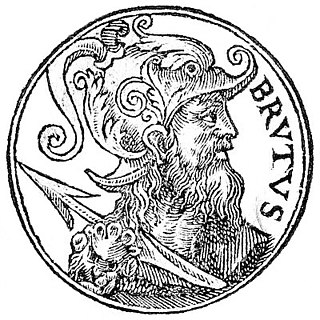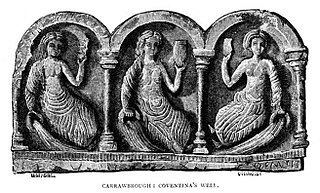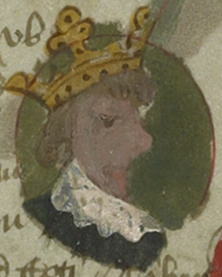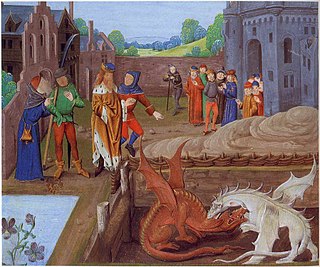
Geoffrey of Monmouth was a Catholic cleric from Monmouth, Wales, and one of the major figures in the development of British historiography and the popularity of tales of King Arthur. He is best known for his chronicle The History of the Kings of Britain which was widely popular in its day, being translated into other languages from its original Latin. It was given historical credence well into the 16th century, but is now considered historically unreliable.

Brutus, also called Brute of Troy, is a legendary descendant of the Trojan hero Aeneas, known in medieval British legend as the eponymous founder and first king of Britain. This legend first appears in the Historia Brittonum, an anonymous 9th-century historical compilation to which commentary was added by Nennius, but is best known from the account given by the 12th-century chronicler Geoffrey of Monmouth in his Historia Regum Britanniae.

The Matter of Britain is the body of medieval literature and legendary material associated with Great Britain and Brittany and the legendary kings and heroes associated with it, particularly King Arthur. The 12th-century Welsh cleric Geoffrey of Monmouth's Historia Regum Britanniae, widely popular in its day, is a central component of the Matter of Britain.

Coel, also called Coel Hen and King Cole, is a figure prominent in Welsh literature and legend since the Middle Ages. Early Welsh tradition knew of a Coel Hen, a c. 4th-century leader in Roman or Sub-Roman Britain and the progenitor of several kingly lines in Yr Hen Ogledd, a region of the Brittonic-speaking area of what is now northern England and southern Scotland.

Camber, also Kamber, was the legendary first king of Cambria, according to the Geoffrey of Monmouth in the first part of his influential 12th-century pseudohistory Historia Regum Britanniae. According to Geoffrey, Cambria, the classical name for Wales, was named for him.

Cassivellaunus was a historical British military leader who led the defence against Julius Caesar's second expedition to Britain in 54 BC. He led an alliance of tribes against Roman forces, but eventually surrendered after his location was revealed to Julius Caesar by defeated Britons.

Leir was a legendary king of the Britons whose story was recounted by Geoffrey of Monmouth in his pseudohistorical 12th-century History of the Kings of Britain. According to Geoffrey's genealogy of the British dynasty, Leir's reign would have occurred around the 8th century BC, around the time of the founding of Rome. The story was modified and retold by William Shakespeare in his Jacobean tragedy King Lear.
Sisillius I was a legendary king of the Britons as accounted by Geoffrey of Monmouth. He came to power in 753BC.

Gorboduc was a legendary king of the Britons as recounted by Geoffrey of Monmouth. He was married to Judon. When he became old, his sons, Ferrex and Porrex, feuded over who would take over the kingdom. Porrex tried to kill his brother in an ambush, but Ferrex escaped to France. With the French king Suhardus, he invaded Britain, but was defeated and killed by Porrex. Porrex was killed in revenge by his own mother Judon, then the high strata of society killed his mother and then there was a war between high strata and low strata leading to an anarchy in the society. This anarchy led to civil war denouncing Gorboduc. Geoffrey does not state when Gorbuduc died, but he is not mentioned after the account of the strife between his sons.
Dyfnwal Moelmud was accounted as an early king and lawmaker among the Welsh, credited with the codification of their standard units of measure. He also figures as a legendary king of the Britons in Geoffrey of Monmouth's pseudohistorical History of the Kings of the Britons.
Catellus was a legendary king of the Britons, as recounted in Geoffrey of Monmouth's work Historia Regum Britanniae. He came to power in 269BC.

Historia regum Britanniae, originally called De gestis Britonum, is a pseudohistorical account of British history, written around 1136 by Geoffrey of Monmouth. It chronicles the lives of the kings of the Britons over the course of two thousand years, beginning with the Trojans founding the British nation and continuing until the Anglo-Saxons assumed control of much of Britain around the 7th century. It is one of the central pieces of the Matter of Britain.
Conan Meriadoc is a legendary British Celtic leader credited with founding Brittany. Versions of his story circulated in both Brittany and Great Britain from at least the early 12th century, and supplanted earlier legends of Brittany's foundation. His story is known in two major versions, which appear in the Welsh text known as The Dream of Macsen Wledig, and in Geoffrey of Monmouth's Historia Regum Britanniae. Both texts associate him with Magnus Maximus, a Roman usurper against the Valentinianic dynasty who was widely regarded as having deprived Britain of its defences when he took its legions to claim the imperial throne. Conan's cousin or sister, Saint Elen, is said to have been Macsen Wledic's wife.
The Treason of the Long Knives is an account of a massacre of British Celtic chieftains by Anglo-Saxon soldiers at a peace conference on Salisbury Plain in the 5th century. The story is thought to be pseudohistorical as the only surviving records mentioning it are centuries later in the semi-mythological histories of the Historia Brittonum and the Historia Regum Britanniae. Though a popular cautionary tale in medieval Europe, there is no other historical evidence for The Treason of the Long Knives. Most historians interpret the story as a purely literary construction.
Llefelys is a character in Welsh mythology appearing in the medieval Welsh tale Cyfranc Lludd a Llefelys. In the tale, Llefelys is king of Gaul while his brother Lludd is king of Britain. The tale appears in the Red Book of Hergest and the White Book of Rhydderch, the source texts for the Mabinogion, and embedded into various versions of the Brut y Brenhinedd, the Welsh adaptation of Geoffrey of Monmouth's Historia Regum Britanniae.
The Coraniaid are a race of beings from Welsh mythology. They appear in the Middle Welsh prose tale Lludd and Llefelys, which survives in the Mabinogion and inserted into several texts of the Brut y Brenhinedd, a Welsh adaptation of Geoffrey of Monmouth's Historia Regum Britanniae. The Coraniaid figure in the tale as one of three plagues that affect Britain during the reign of King Lludd. They are characterized by a sense of hearing so acute that they can hear any word the wind touches, making action against them impossible.

Brut y Brenhinedd is a collection of variant Middle Welsh versions of Geoffrey of Monmouth's Latin Historia Regum Britanniae. About 60 versions survive, with the earliest dating to the mid-13th century. Adaptations of Geoffrey's Historia were extremely popular throughout Western Europe during the Middle Ages, but the Brut proved especially influential in medieval Wales, where it was largely regarded as an accurate account of the early history of the Celtic Britons.
Walter of Oxford was a cleric and writer. He served as archdeacon of Oxford in the 12th century. Walter was a friend of Geoffrey of Monmouth, who claimed he got his chief source for the Historia Regum Britanniae from him.









